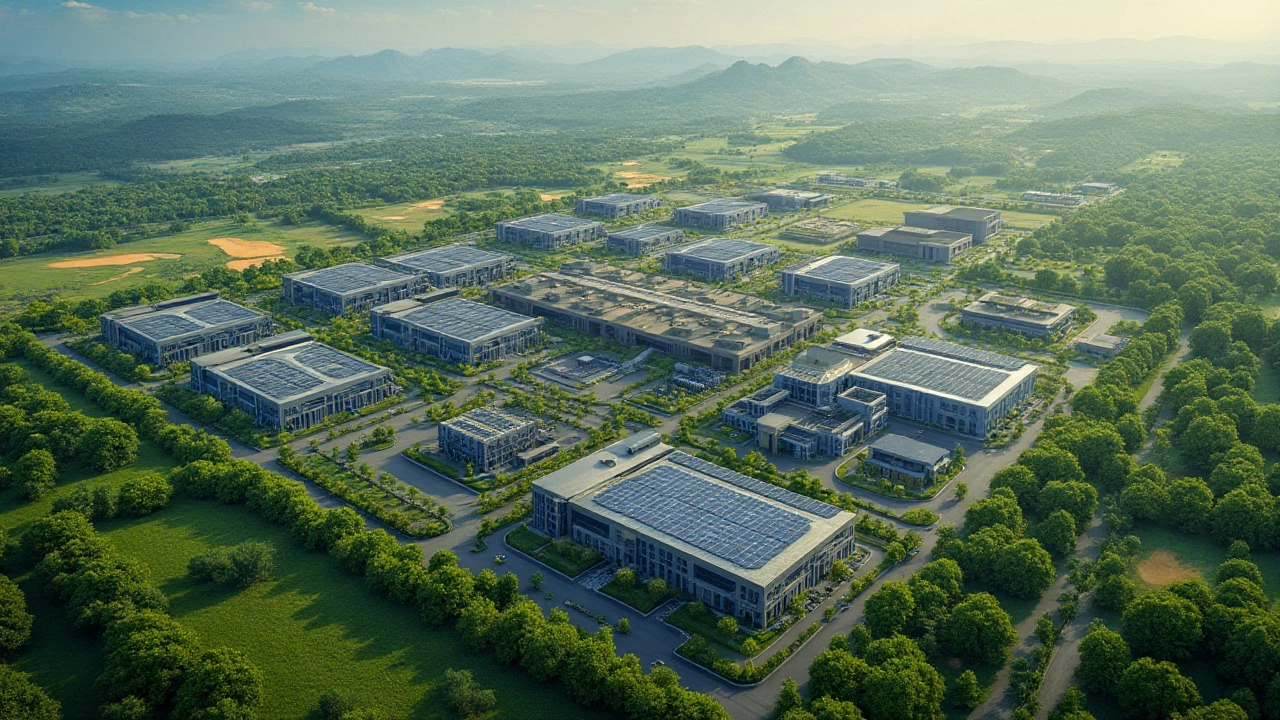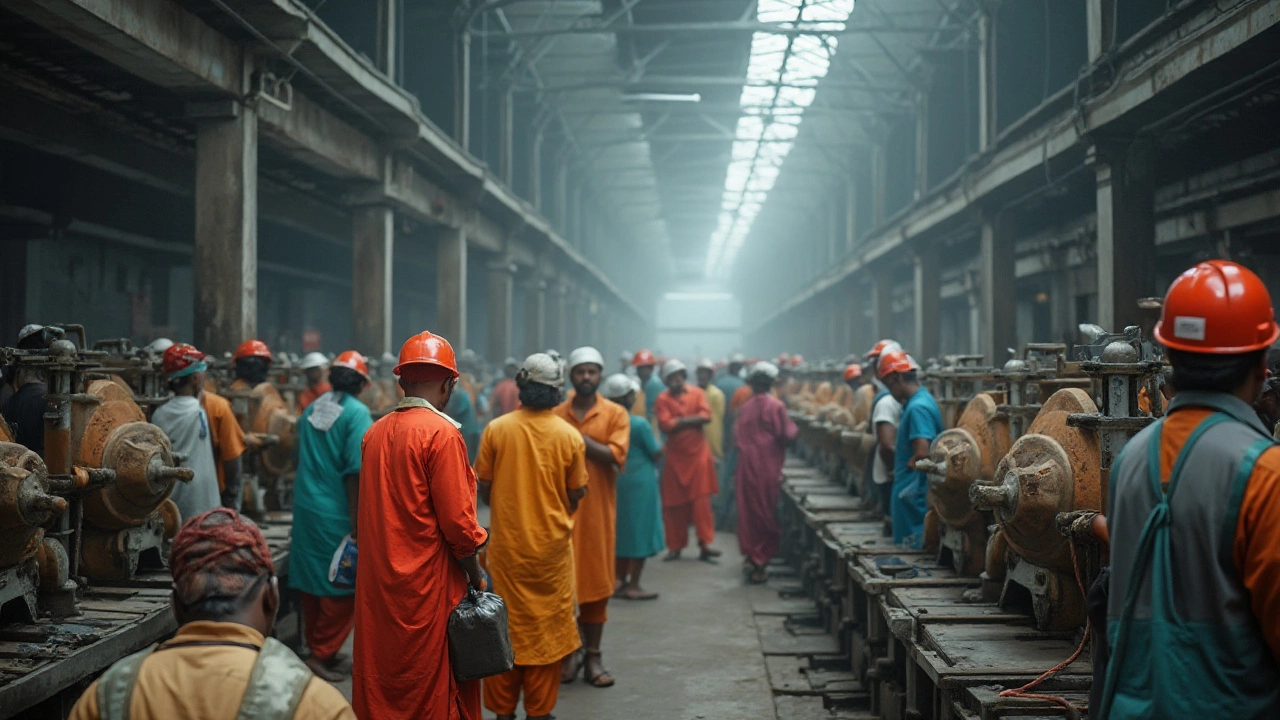Local manufacturing has long been heralded as a cornerstone of robust economic growth and stability. Far from just being about creating goods domestically, it's a multifaceted approach that significantly contributes to a nation's prosperity.
By nurturing industries within national borders, countries can mitigate the heavy dependence on imports, control supply chain disruptions, and foster a culture of innovation.
Amidst global economic shifts, understanding and supporting local manufacturing can offer an indispensable advantage. Dive into this exploration to unearth the profound impacts of these extensively strategized government policies and schemes on our economies.
- Understanding Local Manufacturing
- Economic Benefits of Local Production
- Government's Role in Supporting Industry
- Job Creation Through Local Manufacturing
- Innovation and Sustainability
- Challenges and Future Prospects
Understanding Local Manufacturing
Local manufacturing isn't just about producing goods within a country's borders. It's about fostering a resilient and dynamic production environment that bolsters economic stability and encourages sustainability. At its core, local manufacturing involves a network of supply chain actors including suppliers, manufacturers, distributors, and retailers, all working in harmony to produce and deliver products to consumers. This system supports a myriad of ancillary industries, such as logistics and transportation, creating a ripple effect of economic benefits. By relying on local manufacturing, countries can reduce their vulnerability to global supply chain disruptions, which have become all too common in recent years due to geopolitical tensions and unforeseen crises.
The strategic shift towards local production also empowers nations to develop self-sufficiency. Several countries, recognizing this potential, have implemented government schemes to nurture domestic industries. For example, the 'Make in India' initiative aims to transform India into a global design and manufacturing hub by enhancing skill development and by providing investment opportunities tailored to the needs of 21st-century manufacturing. Such endeavors are instrumental in crafting indigenous capabilities that meet both domestic needs and global market demands.
On occasion, experts have highlighted the significant influence of local production on a country's socio-economic fabric. As E.F. Schumacher pointed out in his pioneering work, "Small is Beautiful": "We must rapidly begin the shift from a 'thing-oriented' society to a 'person-oriented' society." This perspective aligns with the economic growth driven by local manufacturing that prioritizes sustainable development and people over mere profits.
The Multifaceted Benefits
The advantages of investing in local manufacturing extend beyond immediate economic gains. There is an invaluable opportunity to foster innovation by leveraging a region's unique resources and talents. By tailoring production processes to fit the specific needs of the local environment, these industries can create products that are not only high quality but also environmentally sustainable. As a corollary effect, local manufacturing can encourage technological advancements, providing smaller players a platform to contribute to breakthroughs that were once dominated by larger multinational corporations.
Economic statistics consistently point to the multiplier effects of jobs generated by local manufacturing. Simply put, every manufacturing job created can lead to the creation of additional jobs across connected industries. A study by the National Association of Manufacturers in the USA indicated that for every $1.00 spent in manufacturing, another $2.74 is added to the economy, showcasing its pivotal role in economic growth.
In summary, understanding local manufacturing involves seeing it not just as an economic activity but as a strategic asset for national development. It enhances job creation, supports innovation, and builds a resilient economy powered by locally sourced and produced goods. The pursuit of policies promoting local manufacturing is thus more than just an economic choice; it's a strategic necessity for countries aiming to secure their future in an increasingly unpredictable global landscape.
Economic Benefits of Local Production
Local manufacturing is not just about boosting a country's industrial output; it holds the promise of significant economic upliftment. A primary benefit of fostering local manufacturing is the creation of employment opportunities. By establishing production facilities domestically, nations can directly impact job creation, aiding in lowering unemployment rates which might otherwise stunt economic growth. This ripple effect goes further, as more jobs mean increased income, greater purchasing power, and heightened consumer spending, fueling further economic activity.
The establishment of local manufacturing hubs also aids in the reduction of costs associated with transport and import tariffs. These cost savings can then be reallocated to enhance efficiency and innovation within the industries themselves. By producing goods locally, transportation distances are minimized, reducing carbon footprints and contributing to environmental sustainability, aligning with global trends toward eco-friendly practices. Moreover, manufacturing locally circumvents the uncertainties of volatile international trade relations and currency fluctuations, which can often lead to economic instability.
Local production grants a country greater control over the quality of products available to its consumers. With manufacturing taking place within its borders, there is stricter regulation and standardization, which can lead to more robust and trusted products in the market. This builds confidence among consumers and also positions local products as viable substitutes for imported goods, fostering a sense of national pride and preference.
"The move towards localized production addresses gaps in supply chains that global events, such as the recent pandemic, have starkly highlighted," says Sarah Hillman, a distinguished economist with the World Economic Forum.
A noteworthy example of economic revitalization through local manufacturing can be seen in India's 'Make in India' initiative, which aims to boost domestic manufacturing and attract foreign investments. According to a report from 2023, the initiative has already attracted over $60 billion in foreign direct investment, underscoring the potential of domestic manufacturing on the world stage.
In the context of export capabilities, local manufacturing can become a country's gateway to global markets. By increasing the volume of high-quality, domestically produced goods, nations can expand their export portfolios, thereby enhancing their economic footprint internationally. This also fosters economic resilience, as diversity in manufacturing can shield against sector-specific downturns. Investing in local production is tantamount to investing in a nation's future economic health, providing a sturdy foundation for sustained growth and prosperity.

Government's Role in Supporting Industry
Governments around the world have realized the immense potential of encouraging local manufacturing to balance trade, enhance economic resilience, and reduce unemployment. Effective policies and supportive schemes are pivotal in creating a thriving environment where local industries can flourish. From offering tax incentives to simplifying regulatory frameworks, governments are crafting a framework that incentivizes domestic production while also making it competitive on a global scale. A significant driver for these policies is the intention to decrease reliance on imports, thereby ensuring that a country's supply chain remains uninterrupted, especially during global disruptions like pandemics or political tensions.
One common approach that many governments take includes providing financial support and subsidies to startups and manufacturers. This financial aid can range from covering initial capital requirements to providing ongoing relief in times of economic downturns. In India, for example, the "Make in India" initiative has aimed at transforming India into a global manufacturing hub by encouraging both multinational and national companies to produce their goods locally. As a result, there has been significant growth in several sectors, including electronics, textiles, and automobiles.
"Our Government's efforts to bolster local manufacturing are driven not only by economic logic but by a commitment to generating employment and sustainable economic development," says a report from the United Nations Industrial Development Organization (UNIDO).
Moreover, the role of government extends to fostering innovation by investing in research and development. By allocating resources to enhance technological capabilities, governments help local manufacturers stay at the cutting edge. Additionally, skills enhancement programs are frequently promoted to ensure that the workforce is proficient in the latest technologies and techniques required for modern manufacturing processes.
The nurturing of smaller local suppliers is also a part of this grand strategy. Encouraging giant corporations to source components and services domestically can create ripples of growth and productivity, uplifting entire communities. By implementing supporting policies, the government acts as a stimulant, orchestrating sectors to operate synergistically. This not only boosts economic output but also enriches industrial ecosystems across the board, resulting in a vibrant economy that's capable of adapting to new challenges with significant flexibility.
Job Creation Through Local Manufacturing
Local manufacturing is a catalyst for creating a vast number of jobs, significantly impacting communities and the economy at large. When industries are established within a country, they demand a diverse range of skills, from technical expertise in production processes to administrative and managerial roles. This encompassing need provides employment opportunities across various educational backgrounds and skill levels. Moreover, it brings indirect job creation too, as associated services such as logistics, maintenance, and retail are required to support these manufacturing infrastructures. The ripple effect of enhanced employment opportunities can be seen as entire towns and regions benefit from increased economic activity. As jobs multiply, so does disposable income, which fuels consumer spending and, consequently, boosts local businesses and services in a positive feedback loop.
The strategic emphasis on local manufacturing aligns seamlessly with governments' goals of reducing unemployment rates and ensuring equitable economic distribution. With the placement of a manufacturing hub, communities witness an influx of opportunities that were previously inaccessible. These prospects are not only limited to production lines but also extend to research and development sectors, which are critical for advancing technology and fostering innovation. The fact that such industries often promote skill development programs ensures that the workforce remains competitive and competent in adapting to technological advancements and market trends. A study published by the Economic Development Quarterly reveals that manufacturing jobs have a multiplier effect, meaning that for every manufacturing job created, an additional two to three jobs are generated within the community.
Local manufacturing also acts as a training ground for younger generations entering the workforce. Apprenticeship programs and industry partnerships with educational institutions equip individuals with real-world skills, which vastly improve their employability. This fusion of academic knowledge and practical application is invaluable, as it prepares individuals to seamlessly transition from learning environments into the workforce. An anecdote from a well-established local manufacturer illustrates this point: "By collaborating with community colleges, we have not only tailored our workforce to meet current demands but have also ensured a steady pipeline of qualified professionals for the future," noted the company's HR director. This underscores how deep integration between education and industry can yield long-term benefits for both employers and job seekers.
The socioeconomic benefits of job creation through local manufacturing are profound. An increase in employment rates leads to a decrease in poverty levels and crime rates, while community cohesion tends to improve as individuals take pride in contributing to the economy. Moreover, stable jobs contribute to mental well-being and family stability, factors that are often underestimated but vital for societal health. When people have access to secure and well-paying jobs, they are better positioned to invest in their children's education and healthcare, which perpetuates a cycle of growth and prosperity. Thus, initiatives to bolster local manufacturing are not just about meeting economic objectives but about nurturing resilient and thriving communities.
To illustrate the magnitude of local manufacturing in job creation, consider sectors such as textiles, electronics, and automotive, where several countries have shown significant successes. For example, the Indian government’s 'Make in India' campaign has been pivotal in attracting foreign investment and incentivizing domestic production. As of 2023, this initiative has led to the creation of over 10 million jobs across various sectors. Such policies highlight the substantial impact local manufacturing can have, positioning nations as attractive manufacturing hubs and propelling economic growth. These advancements echo throughout the supply chain, affecting suppliers, transport services, and other auxiliary roles, demonstrating the comprehensive influence of robust manufacturing strategies on employment.

Innovation and Sustainability
In the realm of local manufacturing, innovation and sustainability are not just buzzwords but pillars that bolster the enduring growth of industries. As manufacturing firms seek to cement their place in a competitive market, they bank heavily on innovative practices that reduce costs and boost efficiency. This drive often leads to the development of new technologies and processes, thereby creating an environment that not only supports economic growth but also fosters a sustainable footprint. By investing in local industries, governments empower them to adapt flexible production techniques, minimize waste, and conserve energy, which is crucial in meeting the global demand for environmentally responsible production.
The integration of eco-friendly practices within local manufacturing is being recognized worldwide. Countries are increasingly adopting 'green manufacturing' strategies that aim to lower carbon emissions and promote resource efficiency. For instance, Germany's initiatives in the automotive industry include a strong emphasis on designing energy-efficient manufacturing processes and utilizing renewable sources. Such practices reflect a broader global trend where environmental sustainability is blending seamlessly with industrial growth strategies. According to a survey published by the International Energy Agency (IEA), manufacturing industries could achieve up to 40% energy savings by adopting innovative techniques, which underscores the potential for substantial economic benefits.
"Sustainability is no longer about doing less harm. It's about doing more good." – Jochen Zeitz, Former CEO of the international sporting goods company PUMA, embodies the shift in mindset regarding sustainability's role in manufacturing.
Moreover, innovation in local manufacturing is a catalyst for job creation, especially in tech-driven sectors. As companies invest in cutting-edge technologies such as automation, robotics, and machine learning, they simultaneously generate a demand for a new skill set among the workforce. This transition requires a robust educational and training infrastructure that aligns with the needs of modern industries, prompting investments in vocational training programs and partnerships between educational institutions and manufacturing firms.
Data suggests that factories that integrate smart manufacturing technologies can increase their productivity by over 30%. A report by Deloitte insightfully highlights how such advancements lead to more resilient supply chains, allowing manufacturers to predict and adapt to market fluctuations with greater accuracy. This dynamic adaptability not only sustains operations in challenging economic climates but also paves the way for continuous growth and development.
The symbiotic relationship between innovation and sustainability within local manufacturing underscores the profound potential for industries to redefine their role in a rapidly evolving world. As countries continue to focus on local production, integrating sustainable practices will help them secure a stronger economic and environmental future. By encouraging local manufacturers to embrace these twin principles, governments can ensure a balance between economic prosperity and ecological responsibility.
Challenges and Future Prospects
Embarking on the journey of bolstering local manufacturing presents an array of challenges that cannot be ignored. One of the most pressing issues is the infrastructure deficit that many developing countries face. Poor roads, unreliable power supply, and insufficient access to funding can stymie growth at even the most ambitious manufacturing startups. This obstacle demands a concerted effort from both the government and private sector to create an enabling environment where these industries can thrive. With the right infrastructure in place, not only does the cost of production decrease, but the efficiency and speed of manufacturing processes improve, giving local companies a competitive edge.
Another significant challenge is the skills gap within the labor force. Developing nations often struggle with providing the necessary training and education to prepare their workforce for the demands of modern manufacturing. Without the right skills, factories remain imbalanced between high demand and limited output capability. Initiatives that focus on vocational training and partnerships with educational institutions can help bridge this gap. By aligning their curriculum with industry needs, these institutions can ensure a steady influx of trained professionals into the job market, promoting both job creation and economic growth.
Looking to the future, technological advancements present both opportunities and potential pitfalls. Embracing Industry 4.0 and its suite of digital innovations like automation, IoT, and AI promises to revolutionize the way manufacturing is done. However, the integration of these technologies requires significant investment and regulatory support. Governments must be proactive in crafting policies that encourage innovation while safeguarding jobs. Here, it's worth noting Charles Duhigg's observation:
"The goal isn't to strive toward unachievable perfection, but to consistently make meaningful progress."Encouragingly, many countries have recognized this need and are investing in smart manufacturing processes that can catapult them into the forefront of global production.
Environmental sustainability is a growing concern in the manufacturing sector. As the world grapples with the consequences of climate change, there is a mounting pressure on manufacturers to adopt green technologies and reduce their carbon footprint. This not only includes cleaner production processes but also sustainable sourcing of materials and responsible waste management. Future prospects will heavily depend on how skillfully countries navigate this landscape, balancing economic growth with ecological preservation. Successful implementation of green practices can set apart nations as leaders in sustainable manufacturing, attracting both investment and consumer trust.
Finally, geopolitical tensions and changes in international trade policies can have profound effects on local manufacturing economies. Navigating these volatile waters requires resilience and adaptability from both businesses and government entities. Building strong regional alliances and fostering collaborative approaches can provide a buffer against global economic fluctuations. In an interconnected world, no country is an island, and the future of manufacturing will be shaped by the end of diplomacy, collaboration, and innovative problem-solving.

